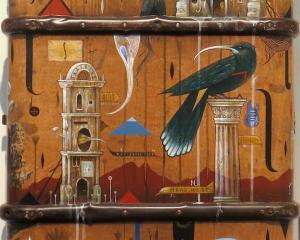![Poipoia te Kākano [installation view]. Allison Beck, Megan Brady, Kate Stevens West, Jess...](https://www.odt.co.nz/sites/default/files/story/2025/02/1_poipoia_te_k_kano.jpg)
(Forrester Gallery, Oamaru))
In a suite of exhibitions co-ordinated by Caitlin Rose Donnelly, Poipoia te Kākano is a diverse group show with a thematic focus on whakapapa and identity.
Allison Beck (Kāi Tahu, Kāti Māmoe, Waitaha, Pākehā) weaves reused materials (newspaper and tape) in deep and shimmering toned ordered layers — a work that seems both communicative and emblematic.
Drawing together pathways of knowledge and connections between people, ancestors, and place, Aramoana (2025), by Megan Brady (Kāi Tahi, Ngāi Tūāhuriri, Pākehā), is a wave-like undulating textile sculpture comprising soft linen and materials that are associated with the ocean.
Three oil and gesso on canvas works by Kate Stevens West (Kāi Tahu, Pākehā) depict beautifully detailed familial scenes that draw nature elements (roots, vines) and ancestral and whānau configurations close together.
Ceramic sculpture by Jess Nicholson (Waitaha, Kāti Māmoe, Kāi Tahu, Ngāi Tūāhuriri, Pākehā) features chain motifs that speak of connections to whenua and of whakapapa; a Tūmatakuru shrub frames Nicholson’s considered approach to using whenua materials.
Sculpture by Donnelly (Kāi Tahu, Kāti Irakehu, Kāti Mako ki Wairewa, Pākehā) includes woollen blankets woven to emulate whaling-chain — materials that have symbolic and historical resonance, and associations with the artist’s tūpuna.
A vibrant contribution by Emma Kitson (Kāi Tahu, Kāti Māmoe, Waitaha) presents a series of neon abstractions that explore patterns associated with both Kitson’s Māori and Scottish whakapapa.
![Whare Takata [installation view] (2024), by Alix Ashworth and Kate Stevens West. Courtesy of the...](https://www.odt.co.nz/sites/default/files/story/2025/02/2_iti_biti_matapihi.jpg)
(Forrester Gallery, Oamaru)
Associated with Poipoia te Kākano, Iti Biti Matapihi is an exhibition about motherhood and everyday lived experience. Both exhibitions include diverse avenues of shared knowledge, collaboration, and personal storytelling.
Reflecting shared moments in time, Caitlin Rose Donnelly’s Trace (2015 and 2025) are mixed-media works on cotton that include painting, mark-making, and stories by the artist’s children.
Inviting interaction, Whare Takata (2024) by Alix Ashworth (Kāi Tahu, Kāti Māmoe, Waitaha) and Kate Stevens West, is a collaboration that includes dolls’-house structures populated by miniature furniture and a host of tiny whenua figures. Stevens West continues this interactive theme with a lightbox work and Ashworth’s transparent panels refract dancing figures in the light.
Zoe Thompson-Moore (Tangata Tiriti-Manx, Irish, English) includes colourful sculptures that reflect on the concept of nurture and illustrate the artist’s playful creative process of hand-cutting glitter from found materials.
Speaking of the significance of rest, Emma Kitson’s ground-level installation is an interactive rest area with highlighter pens to colour in intricate screen-printed upholstery.
Aroha Novak (Tūhoe, Ngāti Kahungunu, Ngāiterangi), Georgina May Young (Te Ūpokorehe, Whakatōhea, Pākehā) and Piupiu Maya Turei (Ngāti Kahungunu ki Wairarapa, Ātihaunui-ā-Pāpārangi) contribute an eye-catching banner of layered woollen blankets with bright embroidered emblems (and kaitiaki); it also forms an interactive space with printed drawings and texts on cushions where children can play.
![Kei te Haere Ahau [installation view] (2025), by Caitlin Rose Donnelly. Courtesy of the artist.](https://www.odt.co.nz/sites/default/files/story/2025/02/3_kei_te_haere_ahau.jpg)
(Forrester Gallery, Oamaru)
In a solo contribution, Caitlin Rose Donnelly presents an installation in the Forrester’s side gallery. It is a large-scale textile work that falls and flows from a central point, filling almost the entire gallery space with red and black fabric.
The work is constructed from bedding materials, where pillowcases and sheets are connected to form a single piece that resembles both a waterfall and a mountain. In the choice of materials, colour and the affective nature of the installation, Kei te Haere Ahau (I am going) presents an interconnected set of concerns or meaning.
For Donnelly, the everyday materials (bedding) speak to daily life and challenges and to motherhood. In these elements, combined with the work’s presentation in the form of awa (water) and the mauka (mountain), is an acknowledgement of the presence of the artist’s ancestors. As the artist puts it: "My everyday life connects me to my tūpuna."
An emotional resonance in this work seems both deeply personal and broadly meaningful. The experience of viewing this work was another reminder of the privilege to be invited, through the art, to witness and appreciate the lived experiences of others.
Overall, the range of thought-provoking depth and the expressions of joy present across these three exhibitions at the Forrester is an engaging and inspiring experience for the viewer.
By Joanna Osborne












